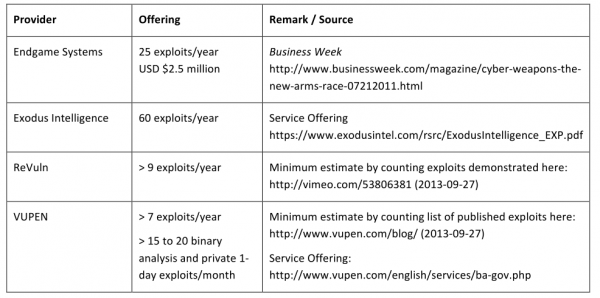On any given day, nation-states and criminal hackers have access to an entire arsenal of zero-day vulnerabilities — undocumented and unpatched software flaws that can be used to silently slip past most organizations’ digital defenses, new research suggests. That sobering conclusion comes amid mounting evidence that thieves and cyberspies are ramping up spending to acquire and stockpile these digital armaments.
Security experts have long suspected that governments and cybercriminals alike are stockpiling zero-day bugs: After all, the thinking goes, if the goal is to exploit these weaknesses in future offensive online attacks, you’d better have more than a few tricks up your sleeve because it’s never clear whether or when those bugs will be independently discovered by researchers or fixed by the vendor. Those suspicions were confirmed very publicly in 2010 with the discovery of Stuxnet, a weapon apparently designed to delay Iran’s nuclear ambitions and one that relied upon at least four zero-day vulnerabilities.
Documents recently leaked by National Security Agency whistleblower Edward Snowden indicate that the NSA spent more than $25 million this year alone to acquire software vulnerabilities from vendors. But just how many software exploits does that buy, and what does that say about the number of zero-day flaws in private circulation on any given day?
These are some of the questions posed by Stefan Frei, research director for Austin, Texas-based NSS Labs. Frei pored over reports from and about some of those private vendors — including boutique exploit providers like Endgame Systems, Exodus Intelligence, Netragard, ReVuln and VUPEN — and concluded that jointly these firms alone have the capacity to sell more than 100 zero-day exploits per year.
According to Frei, if we accept that the average zero-day exploit persists for about 312 days before it is detected (an estimate made by researchers at Symantec Research Labs), this means that these firms probably provide access to at least 85 zero-day exploits on any given day of the year. These companies all say they reserve the right to restrict which organizations, individuals and nation states may purchase their products, but they all expressly do not share information about exploits and flaws with the affected software vendors.
KNOWN UNKNOWNS
That approach stands apart from the likes of HP TippingPoint‘s Zero-Day Initiative (ZDI) and Verisign‘s iDefense Vulnerability Contributor Program (VCP), which pay researchers in exchange for the rights to their vulnerability research. Both ZDI and iDefense also manage the communication with the affected vendors, ship stopgap protection for the vulnerabilities to their customers, and otherwise keep mum on the flaws until the vendor ships an update to fix the bugs.
Frei also took stock of the software vulnerabilities collected by these two companies, and found that between 2010 and 2012, the ZDI and VCP programs together published 1,026 flaws, of which 425 (44 percent) targeted flaws in Microsoft, Apple, Oracle, Sun and Adobe products. The average time from purchase to publication was 187 days.
“On any given day during these three years, the VCP and ZDI programs possessed 58 unpublished vulnerabilities affecting five vendors, or 152 vulnerabilities total,” Frei wrote in a research paper released today.
Frei notes that the VCP and ZDI programs use the information they purchase only for the purpose of building better protection for their customers, and since they share the information with the software vendors in order to develop and release patches, the overall risk is comparatively low. Also, the vulnerabilities collected and reported by VCP and ZDI are not technically zero-days, since one important quality of a zero-day is that it is used in-the-wild to attack targets before the responsible vendor can ship a patch to fix the problem.
In any case, Frei says his analysis clearly demonstrates that critical vulnerability information is available in significant quantities for private groups, for extended periods and at a relatively low cost.
“So everybody knows there are zero days, but when we talk to C-Level executives, very often we find that these guys don’t have a clue, because they tell us, ‘Yeah, but we’ve never been compromised’,” Frei said in an interview. “And we always ask them, ‘How do you know?'”
Frei said that in light of the present zero-day reality, he has three pieces of advice for C-Level executives:
- Assume you are compromised, and that you will get compromised again.
- Prevention is limited; invest in breach detection so that you can quickly find and act on any compromises.
- Make sure you have a process for properly responding to compromises when they do happen.
- ANALYSIS
Although’s Frei’s study is a very rough approximation of the zero-day scene today, it is almost certainly a conservative estimate: It makes no attempt to divine the number of zero-day vulnerabilities developed by commercial security consultancies, which employ teams of high-skilled reverse engineers who can be hired to discover flaws in software products.
Nor does it examine the zero-days that are purchased and traded in the cybercriminal underground, where vulnerability brokers and exploit kit developers have been known to pay tens of thousands of dollars for zero-day exploits in widely-used software. I’ll have some of my own research to present on this latter category in the coming week. Stay tuned. Update, Dec. 6, 1:30 p.m. ET: Check out this story on the arrest of the man thought to be behind the Blackhole Exploit Kit. He allegedly worked with a partner who had a $450,000 budget for buying browser exploits.
Original story:
But Frei’s research got me to thinking again about an idea for a more open and collaborative approach to discovering software vulnerabilities that has remained stubbornly stuck in my craw for ages. Certainly, many companies have chosen to offer “bug bounty” programs — rewards for researchers who report zero-day discoveries. To my mind, this is good and as it should be, but most of the companies offering these bounties — Google, Mozilla, and Facebook are among the more notable — operate in the cloud and are not responsible for the desktop software products most often targeted by high-profile zero-days.
After long resisting the idea of bug bounties, Microsoft also quite recently began a program to pay researchers who discover novel ways of defeating its security defenses. But instead of waiting for the rest of the industry to respond in kind and reinventing the idea of bug bounties one vendor at a time, is there a role for a more global and vendor-independent service or process for incentivizing the discovery, reporting and fixing of zero-day flaws?
Most of the ideas I’ve heard so far involve funding such a system by imposing fines on software vendors, an idea which seems cathartic and possibly justified, but probably counterproductive. I’m sincerely convinced that a truly global and remunerative bug bounty system is possible and maybe even inevitable as more of our lives, health and wealth become wrapped up in technology. But there is one sticking point that I simply cannot get past: How to avoid having the thing backdoored or otherwise subverted by one or more nation-state actors?
I welcome a discussion on this topic. Please sound off in the comments below.























